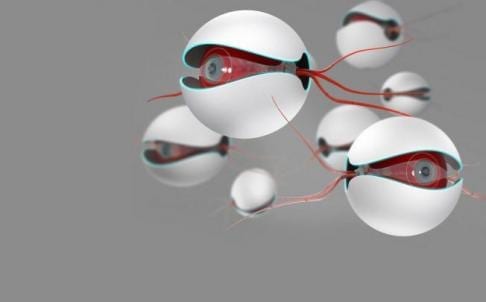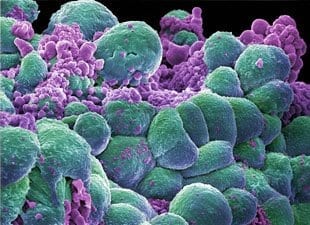
Nanoparticles programmed to dispatch drugs to specific parts of the body could make surgery a thing of the past
Imagine swallowing a pill of tiny molecular robots that can hone in on any injured part of your body and perform repairs. In 1959, the Nobel Laureate Richard Feynman predicted that we would one day be able to “swallow the doctor” to heal ailments from inside our bodies.
Today, nanotechnology is bringing the dream of that pill closer to reality. Medicines are being developed to be just like the small seeds of the burr plant, covered in tiny hooks that cling onto your socks as you walk through the grass. Submicroscopic nanoparticles are designed to bind tightly to specific targets within the body and release drugs slowly and steadily.
“If you put 1,000 nanoparticles side by side they are about the width of a human hair,” says Dr Juliana Chan, adjunct assistant professor at the Nanyang Technological University (NTU) in Singapore.
Hong Kong University Professor So Kwok-fai specialises in neuroscience and has developed a nanoparticle in collaboration with MIT to support regeneration after nerve damage. Explaining why this treatment is needed, So says: “The central nervous system is unable to repair itself because the nerve microenvironment does not support neuron regeneration.”
The nanoparticle is made by linking amino acids, the building blocks of protein. When the nanoparticles come in contact with blood, they self-assemble into a nanofibre scaffold. This scaffold can bridge gaps in damaged tissue and provide a framework for nerve regeneration. For example, So has tested his formulation on laboratory animals to repair optic nerveS, resulting in functional vision.
An unexpected finding was that the nanoparticles were able to stop bleeding, a major problem during neurosurgery. During a surgical experiment, So’s team was surprised to find that the laboratory animal did not bleed after the nanoparticle solution was applied. They realised that the nanoparticles were an effective means to stop bleeding, which leads to faster recovery after surgery. “An analogy would be like beavers building a dam with wood instantaneously so the flow of water can be stopped right away,” says So.
With the discovery of a way to stop bleeding almost instantly during neurosurgery, this important risk can be better managed. He says: “Normally it would take more than 90 seconds for platelets to amass at the site of the wound, form a blood clot and stop the bleeding. But the application of the nanomaterial was able to stop the bleeding within 15 seconds.”
Dr Kenneth Wong, clinical assistant professor at HKU’s Department of Surgery, studies the use of nanoparticles made from silver. His research focuses on applying silver nanoparticles to skin burns, surgical wounds and even bone fractures to help repair and regeneration. Wong’s team has shown that silver nanoparticles can stimulate skin cells to grow and divide more rapidly to close a wound, as well as push underlying cells to help contract the wound. Silver nanoparticles are now incorporated into wound dressings for treatment.
Over in Singapore, NTU’s Chan first started working on “nanoburrs” in Professor Robert Langer‘s laboratory at the Massachusetts’s Institute of Technology (MIT) in the US, where she developed nanoparticles to deliver drugs to injured blood vessels. Nanoburrs are nanoparticles coated with a sticky protein that makes them cling onto artery walls while they slowly release drugs.
To treat atherosclerosis, which is caused by accumulation of fat within blood vessels that serve the heart, doctors may perform surgery and use a microscopic balloon to open up the narrowed blood vessels. However, this treatment could damage the artery walls and when the body repairs the damage, the blood vessels become narrow again. To prevent this, drugs are applied to limit the growth of scar tissue within the blood vessel.
Just 60 nanometres (or 60 billionths of a metre) wide, the MIT nanoparticles can carry a drug load and bind only to damaged parts of the blood vessels around the heart. They are made from materials that are compatible with the body and can be broken down harmlessly when finished.
Nanoburrs are layered like an onion. The outer coating protects the internal layers as the particle travels through the blood and is made from a material less easily detected by the body’s immune system. This outer coating also comprises protein “hooks”, like the outer covering of burr seeds, which can bind to specific targets in the body. The middle layer is a fatty material while the inner core contains the drug. Once bound, the nanoparticles release the drug gradually over a long period of time. This can be over days and weeks, which is much longer than when we take regular medication.
Chan believes that nanoparticles are making more drugs available.
“Nanoparticles have revolutionised the delivery of drugs. Drugs with poor profiles that were routinely discarded, for being too hydrophobic [water-repellent] for example, and previously had poor bioavailability can now be encapsulated in nanoparticles to improve their solubility and pharmacokinetic profiles.”
Researchers at the Brigham and Women’s Hospital in the US are also using nanoparticles to tackle inflammations. Inflammation is caused by large numbers of white blood cells infiltrating a site in the body. Prolonged excessive inflammation causes diseases such as atherosclerosis, arthritis and type 2 diabetes.
Nanoparticles carrying anti-inflammatory drugs and designed to attach to inflamed tissues are effective in delivering treatment to where it is needed. Because the nanoparticles release their anti-inflammatory cargo slowly over time and in a sustained manner, this form of treatment can be used to bring inflammation under control.
The Latest Bing News on:
Nanomedicine
- Multiple sclerosis patients find hope in ‘liquid gold’on May 1, 2024 at 12:34 pm
The world has over 1.8 million people with multiple sclerosis in the world, according to the World Health Organization in 2023. The Mayo Clinic says it attacks a person’s nervous system, causing ...
- ‘Liquid gold’ could bring new hope to multiple sclerosis patients, study suggests: ‘Profound benefit’on April 30, 2024 at 2:30 am
An experimental medication called CNM-Au8 — a drinkable liquid with gold nanocrystals — has shown promising results in clinical trials for improving MS symptoms. Doctors and researchers weighed in.
- Nanomedicine for Rare Diseaseson April 15, 2024 at 1:42 am
The development of nanomedicine began in the early 1990s as a promising technique with many therapeutical benefits, with applications in areas such as neurodegenerative and infectious diseases, as ...
- Raman Spectroscopy in Nanomedicineon April 10, 2024 at 5:00 pm
Raman spectroscopy is a branch of vibration spectroscopy that is capable of probing the chemical composition of materials. Recent advances in Raman microscopy have significantly added to the range ...
- Raman Spectroscopy in Nanomedicineon April 5, 2024 at 5:00 pm
Nanomedicine. 2013;8(8):1335-1351. Spontaneous Raman spectroscopy has, therefore, already been demonstrated to be a chemically specific method for investigating nanoparticle interactions and to ...
- Nanomedicine Market Size Expected to Reach USD 562.93 Bn by 2032on April 3, 2024 at 8:00 am
Ottawa, April 03, 2024 (GLOBE NEWSWIRE) -- The global nanomedicine market size was valued at USD 219.34 billion in 2023 and is predicted to hit around USD 494.62 billion by 2031, a study published ...
- Nanomedicine News and Researchon February 19, 2024 at 4:00 pm
Biomaterials and Nanomedicine, in collaboration with the Instituto de Investigación Sanitaria La Fe and the University of Zaragoza proposes a novel approach to slow neuromuscular degeneration in ...
- Fundamentals of Nanomedicineon February 6, 2024 at 6:36 pm
Presenting a thorough discussion of the science and engineering of nanomedicine, it discusses vital environmental, social and ethical impacts of this revolutionary technology. Including over 200 ...
- Nanomedicine advancement shows potential for personalized point-of-care therapeuticson February 6, 2024 at 9:21 am
"We encapsulated this molecule into our nanomedicine formulations and showed that it actually stops those prostate cancer cells from growing." Based on this example, the team's research has ...
- MSc Nanomedicine by Researchon March 2, 2022 at 7:00 am
We reserve the right to close applications if the course is full. Understand the role of nanomedicine within healthcare innovation, particularly focussing on the delivery of therapeutics (including ...
The Latest Google Headlines on:
Nanomedicine
[google_news title=”” keyword=”Nanomedicine” num_posts=”10″ blurb_length=”0″ show_thumb=”left”] [/vc_column_text]The Latest Bing News on:
Nanoparticles
- Scientists solved the 70-year-old mystery of an insect's invisibility coat that can manipulate lighton May 4, 2024 at 2:51 am
For the first time, scientists at Pennsylvania State University have created synthetic replicas of brochosomes, naturally occurring nanoparticles that could one day be used to make invisibility ...
- Towards transparent and antimicrobial surfaces for touch displayson May 3, 2024 at 9:07 am
Researchers report the development of a durable and transparent antimicrobial surface containing copper nanoparticles. The nanostructured surface was obtained by dewetting ultrathin metal copper films ...
- Nanotubes, nanoparticles and antibodies detect tiny amounts of fentanylon May 2, 2024 at 1:22 pm
A research team at the University of Pittsburgh led by Alexander Star, a chemistry professor in the Kenneth P. Dietrich School of Arts and Sciences, has developed a fentanyl sensor that is six orders ...
- Activity in a Room Stirs Up Nanoparticles Left by Consumer Sprayson May 2, 2024 at 1:18 am
Common household products containing nanoparticles could be contributing to a new form of indoor air pollution, as activity in a room stirs up the nanoparticles and projects them into the breathing ...
- Household sprays release dangerous nanoparticles that linger in the homeon May 1, 2024 at 10:30 am
Walking through a recently sprayed area can resuspend nanoparticles in the household up to adult breathing levels.
- A New Delivery System Offers Hope for Cystic Fibrosison May 1, 2024 at 7:52 am
CRISPR-carrying lipid nanoparticles enabled researchers to correct a rare nonsense mutation in the lungs of a cystic fibrosis mouse model.
- Activity in a room stirs up nanoparticles left over from consumer sprays, study showson April 30, 2024 at 11:13 am
Common household products containing nanoparticles—grains of engineered material so miniscule they are invisible to the eye—could be contributing to a new form of indoor air pollution, according to a ...
- Activity in a Room Stirs up Nanoparticles Left Over From Consumer Sprayson April 30, 2024 at 10:13 am
Common household products containing nanoparticles – grains of engineered material so miniscule they are invisible to the eye – could be contributing to a new form of indoor air pollution, according ...
- Penn bioengineering professor develops lipid nanoparticles to deliver mRNA inside human cellson April 29, 2024 at 12:28 am
Associate professor Michael Mitchell is developing novel lipid nanoparticles that can deliver mRNA inside human cells (Photo from Penn Engineering). Michael Mitchell, an associate professor of ...
- Tiny heat pump that relies on changing ambient temperature could be key to powering IoT devices and sensors without batteries forever — Nanoparticles are critical to the ...on April 28, 2024 at 10:46 pm
As IoT technology progresses, the question of how to power these devices, particularly in locations where reliable electrical sources are scarce, presents a significant challenge. Researchers at the ...
The Latest Google Headlines on:
Nanoparticles
[google_news title=”” keyword=”Nanoparticles” num_posts=”10″ blurb_length=”0″ show_thumb=”left”]










